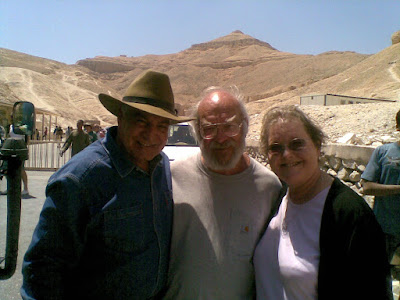The title "scribe"
His titles and name are usually followed by the hieroglyphs for "true of voice", interpreted as "justified" or "deceased". This originates from the fact that the dead person must appear before Osiris and the scales of truth (the "weighing of the heart ceremony"), where his heart is weighed against the feather, the symbol of the goddess of truth, order and justice, Ma'at. If the heart equals the weight of the feather then the person is proved true and honest, i.e. justified, and can proceed into to afterlife. The scene of the "weighing of the heart" does not appear in this tomb.
Despite the small size of the tomb it can hardly one of a poor man or a person of no important position. To have the wherewithal in order to produce a tomb of this quality he certainly had something, perhaps he had close connections with the royal court or the royal family itself, although there is no indication of this in the tomb decoration. Regarding the period in which he lived, there can be not doubt, the erasure of the name of Amon from the texts in the complex shows that it was at least prior to the Akhenaton era. As discussed above, the relationship of the decorative style indicates that he must have lived during the reign of Thutmosis IV and Amenhotep III.
- On the north wall, upper register, she is "His sister, his beloved, the chantress of [Amon], Tawy.". On the lower register, the columns above the couple have been left without text.
- On the south wall, she is only mentioned in the badly damage area of the false door (centre top), where all that remains for certain is "mistress of the house".
- On the east wall - left-hand side, there is only room for "His sister, the chantress of [Amon], Tawy, justified.". However, only the last two characters of "His sister" and "justified" have survived the removal of the name "Amon".
- On the east wall - right-hand side, she is named once: "His sister, his beloved, with a place in his heart, the chantress of [Amon, Tawy], justified." Here her actual name has been lost by the removal of "Amon".
- On the west wall - right-hand side, she is mentioned twice in the upper register on the left-hand side. Firstly in the blue text, as: "His sister, the chantress of [Amon], mistress of the house, Tawy." Then, in multi-colour, as: "His sister, his beloved, with a place in his heart, [the chantress of Amon], Tawy."
- On the west wall - left-hand side, no text to identify her has survived, the only text is that which states that the son is hers.
Note that she is only referred to as "justified" twice. Also, again only twice, is she referred to as "mistress of the house", which actually identifies her as "his wife"; the term "sister" being used for both "wife" and "sister".
Tawy held the title as "chantress of Amon", like most women with any resemblance of rank, thus it is uncertain that the title entailed anything other than being possibly associated with the temple of Amon, just as her husband was.
- Other sons and daughters doubtless appear in the tomb, but were never specifically inscribed as being such or even named.
• Parents and other family members : there is no mention of his or his wife's parents in either the texts or the imagery. Nor are there any indications to their ancestry. Neither is there any information about the previous marriage of Tawy, other than the fact the son is identified solely as hers.








